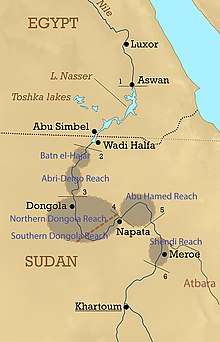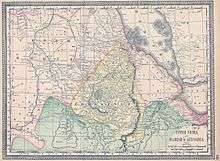Upper Nubia
Upper Nubia is the southernmost part of Nubia, upstream on the Nile from Lower Nubia. It is so called because the Nile flows north, so it is further upstream and of higher elevation in relation to Lower Nubia.
The extension of Upper Nubia is rather ill-defined and depends on the researchers’ approach.
Geographical approach

Geographically speaking Upper Nubia designs the area between the Second and the Sixth cataracts of the Nile. Occasionally the term Middle Nubia is used to design the area between the Second and the Third cataract; in this case Upper Nubia begins at the Third cataract going upstream.[1]
Physiographic subdivisions of Upper Nubia alongside the Nile cataracts:[2]
| Area | From | To |
|---|---|---|
| Batn-El-Hajar | Second cataract | Dal cataract |
| Abri-Delgo Reach | Dal cataract | Third cataract |
| Dongola Reach | Third cataract | Fourth cataract |
| Abu Hamed Reach | Fourth cataract | Fifth cataract |
To be defined |
Fifth cataract | Confluence of Atbara and Nile rivers |
| Shendi Reach | Confluence of Atbara and Nile rivers | Sixth cataract |
Political approach
Politically speaking Upper Nubia falls in present northern and central Sudan stretching from the Egyptian border south to present-day Khartoum at the confluence of White Nile and Blue Nile.[3]
Historical approach

Historically speaking Upper Nubia comprises the areas of influence of the Nubian part of New Kingdom Egypt or the kingdom of Kush or Meroe.[1] Connecting the Mediterranean world with inner Africa, Upper Nubia was crisscrossed by important trade routes and has been the cradle of diverse cultures.
| Civilization | Endurance from | Endurance to |
|---|---|---|
| Kerma culture | 2500 BCE | 1500 BCE |
| New Kingdom of Egypt | 1550 BCE | 1080 BCE |
| Kingdom of Kush | c. 800 BCE | 4th century CE |
| Christian Nubia (Makuria and Alodia) | 6th century AD | c. 1500 |
| Funj Sultanate | 1504 | 1821 |
References
- Török, László (2008). Between Two Worlds: The Frontier Region Between Ancient Nubia and Egypt 3700 BC - 500 AD. Brill. p. XXI. ISBN 978-90-04-17197-8.
- William Yewdale Adams; Nubia: Corridor to Africa; 1977; ISBN 978-0-7139-0579-3.
- Barbara Ann Kipfer; Upper Nubia in: Encyclopedic Dictionary of Archaeology; 2000; ISBN 978-0-306-46158-3.